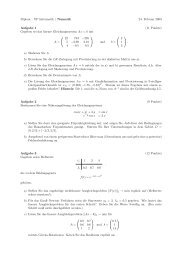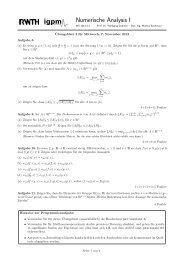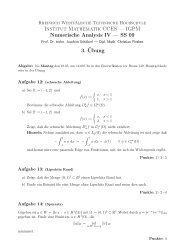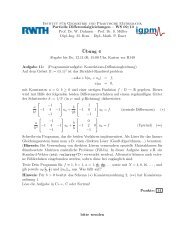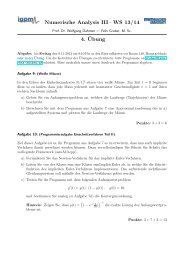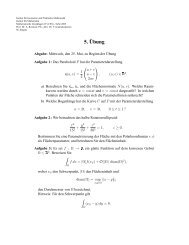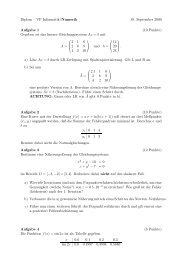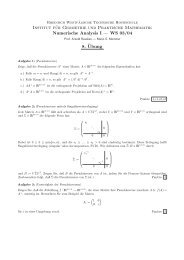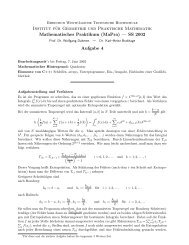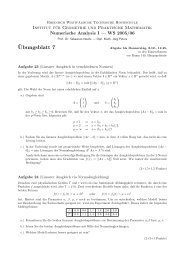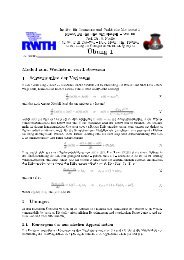Variable-step preconditioned conjugate gradient method for partial ...
Variable-step preconditioned conjugate gradient method for partial ...
Variable-step preconditioned conjugate gradient method for partial ...
You also want an ePaper? Increase the reach of your titles
YUMPU automatically turns print PDFs into web optimized ePapers that Google loves.
6 Numerical results<br />
All numerical results in this section can be devided into two parts. First of all, we present the<br />
numerical results <strong>for</strong> finding the smallest eigenpair {λ1, u1}, The second part of experiments shows<br />
efficiency and robustness of the <strong>method</strong> <strong>for</strong> computing the smallest eigenspace <strong>for</strong> various number<br />
of vectors.<br />
As a model problem, which has the exact (analytical) solution, we consider the Laplace operator<br />
on square (cube) domain with homogeneous Dirichlet boundary conditions, i.e., we solve the<br />
following eigenvalue problem<br />
A vi = λivi, �vi� = 1, λi > 0, i = 1, 2, . . . , p ≤ m, (17)<br />
which corresponds to the piecewise–linear finite–element discretization of the two (three) dimensional<br />
second–order elliptic problems<br />
�<br />
∂<br />
− a11<br />
2u ∂<br />
+ a22<br />
∂x2 2u ∂y2 �<br />
∂<br />
+a33<br />
2u ∂z2 ��<br />
= λu, in Ω,<br />
(18)<br />
�u� = 1, u = 0 on ΓD = ∂Ω,<br />
Table 1. Number of iterations <strong>for</strong> LOBPCG-VS <strong>method</strong>, 2D case, m = 1, p = 1<br />
N (2D case) 4 8 16 32 64 128 256<br />
with DIAG preconditioner<br />
a11 = 1, a22 = 1 8 20 40 74 133 233 418<br />
a11 = 1, a22 = 10 −1 10 41 74 138 238 436 624<br />
a11 = 1, a22 = 10 −2 33 53 160 343 486 674 1290<br />
a11 = 1, a22 = 10 −3 48 59 164 393 904 1924 3597<br />
with ICF preconditioner<br />
a11 = 1, a22 = 1 4 6 6 5 5 4 4<br />
a11 = 1, a22 = 10 −1 7 10 8 8 7 7 5<br />
a11 = 1, a22 = 10 −2 7 15 19 18 11 10 10<br />
a11 = 1, a22 = 10 −3 7 21 29 38 26 26 26<br />
with AMG preconditioner<br />
a11 = 1, a22 = 1 3 6 6 5 5 4 4<br />
a11 = 1, a22 = 10 −1 3 7 8 8 7 7 5<br />
a11 = 1, a22 = 10 −2 3 7 15 18 11 10 10<br />
a11 = 1, a22 = 10 −3 3 7 15 31 26 26 24<br />
in the square (cube) domain Ω = [0, 1] × [0, 1](×[0, 1]) on a uni<strong>for</strong>m Cartesian mesh Th with<br />
<strong>step</strong>size h = N −1 , by the above <strong>method</strong> begining with the random initial guess x (0) and continue<br />
the iterative process untill the following stopping criterion<br />
δk<br />
δ0<br />
< εout = 10 −6 , δk = max<br />
1≤j≤p �r(k)<br />
j �,<br />
was satisfied. Here p is a number of desired eigenvectors and m is the number of test vectors used.<br />
Moreover, the preliminary tests and Corollary 1 shown that the rate of convergence is weakly<br />
depend on the inner stopping criteria when εin goes to zero, but at the same time the corresponding<br />
computational costs are considerable increased. Thus, in what follows we use εin = 10 −1 .<br />
In all Tables of this section DIAG denotes the LOBPCG <strong>method</strong> with the diagonal preconditioner,<br />
i.e., M = diag(A), ICF and AMG denotes the LOBPCG-VS <strong>method</strong> with incomplete<br />
factorization and algebraic multigrid preconditioner, respectively.<br />
9



